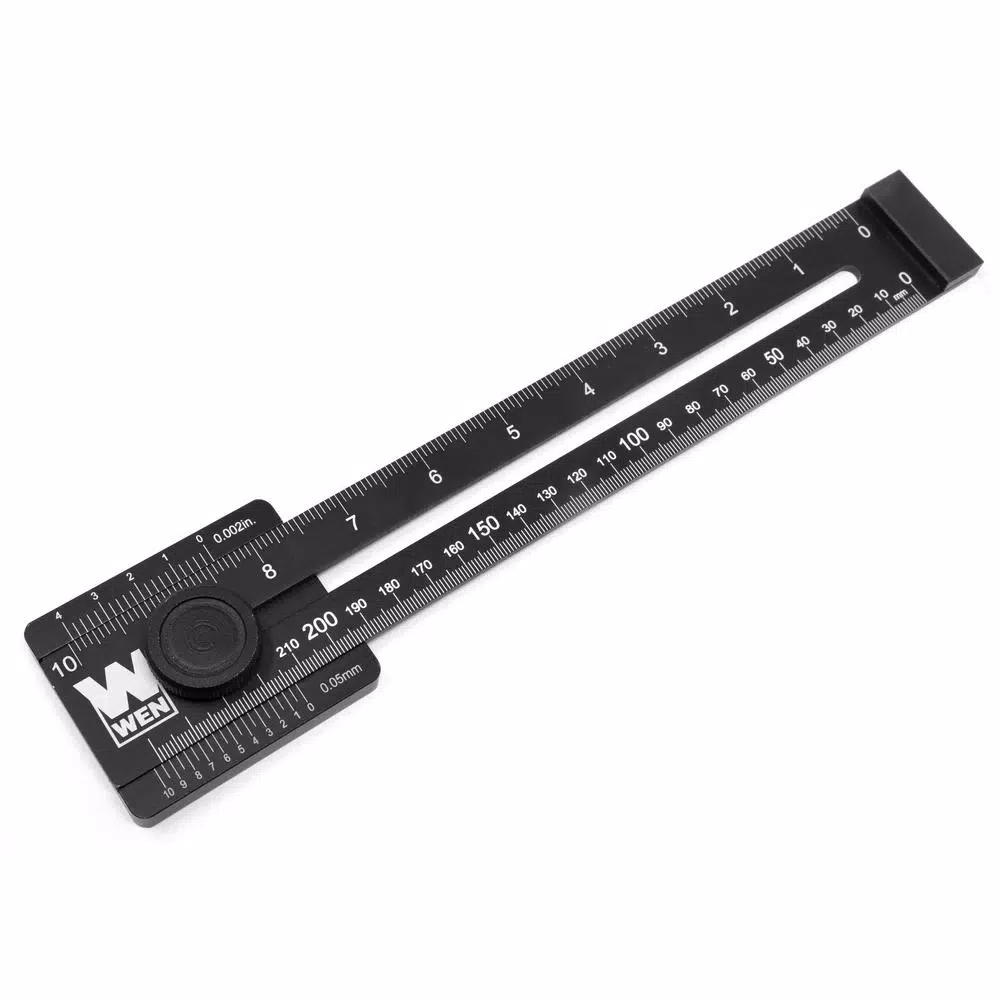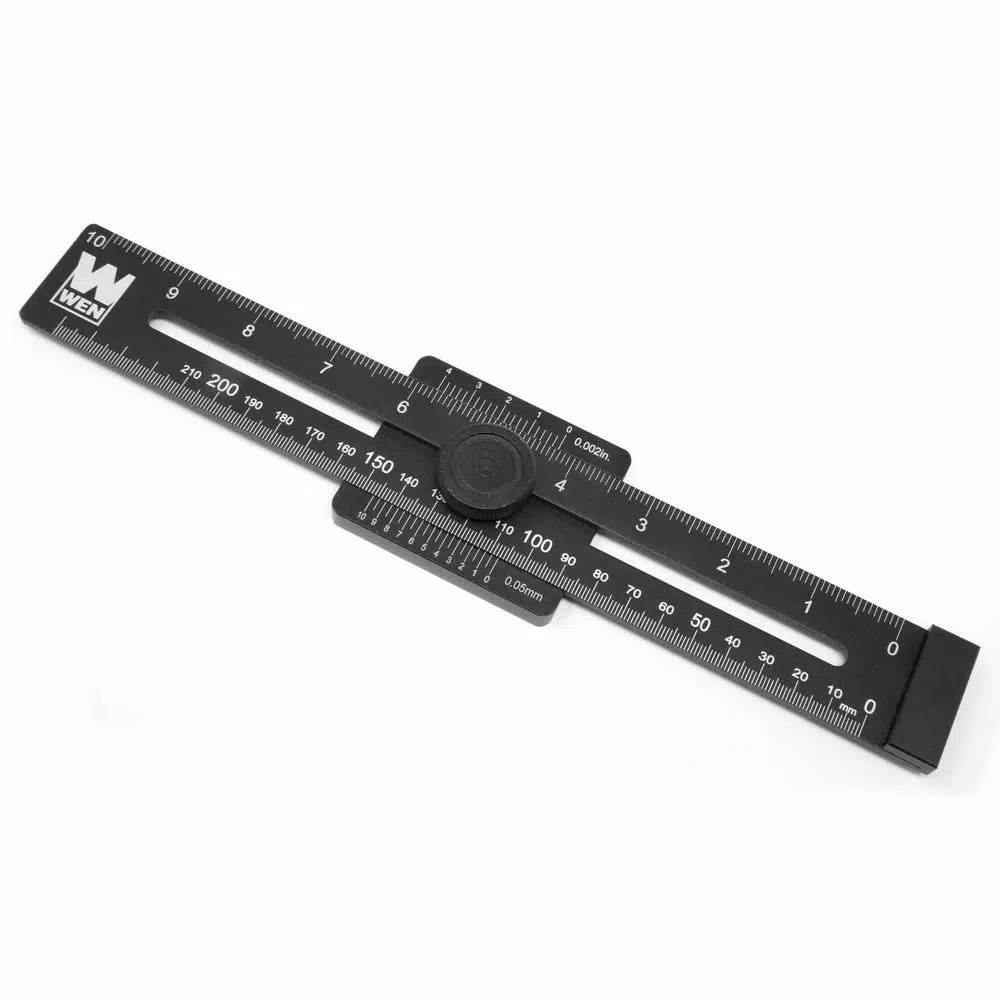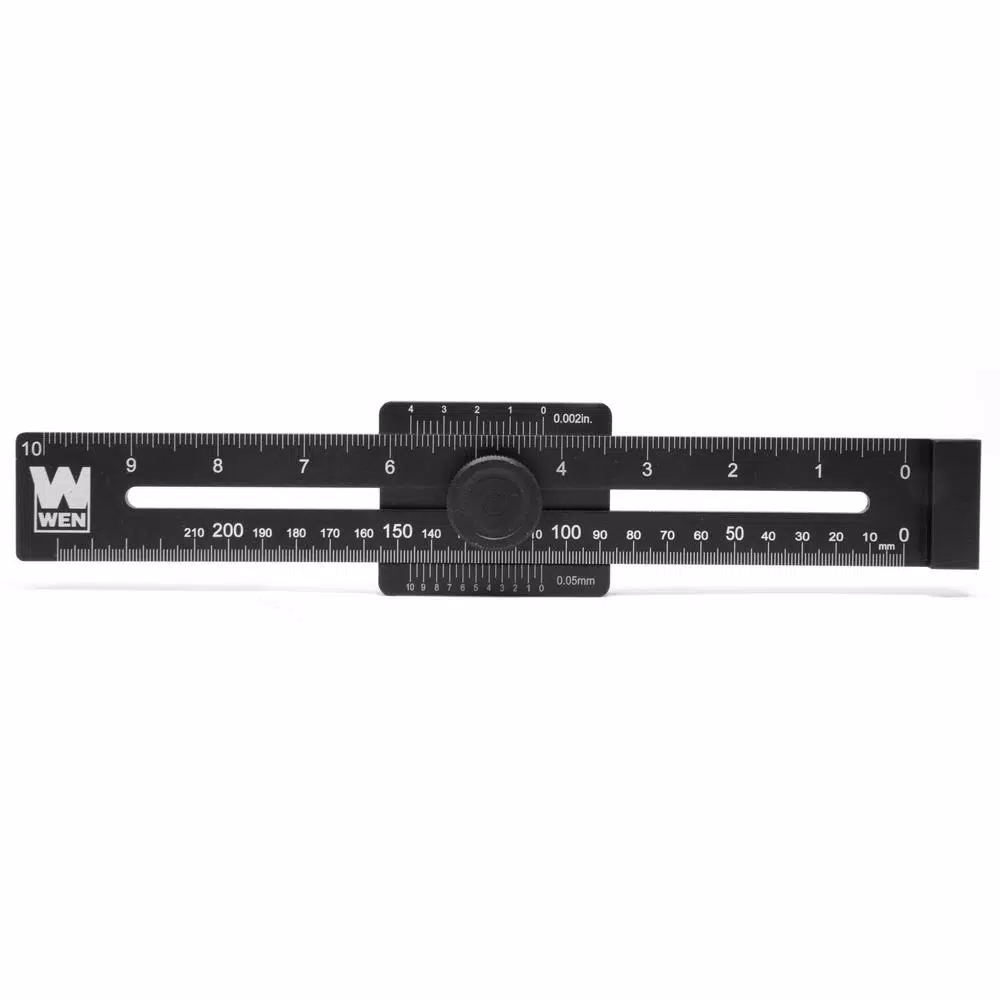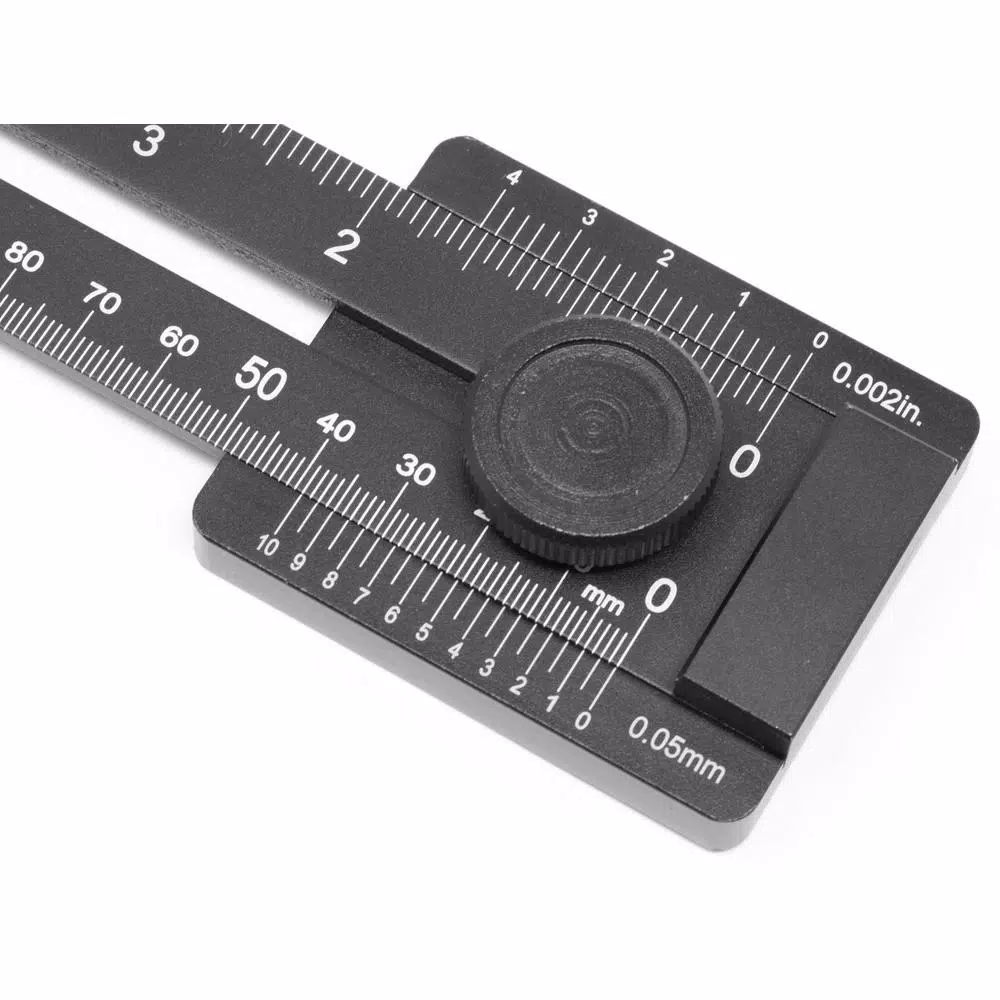WEN 10 in. Aluminum Offset Marking Gauge and Layout Tool with Laser-Etched Scale
$16.02
In stock
Description
Remember when you had an offset gauge, ruler and adjustable square all in 1-tool. The WEN Aluminum Marking Gauge provides a variety of helpful woodworking applications for users of all kinds. Unlock the center knob to freely slide the gauge back and forth. This allows you to manually take caliper-grade measurements with 0.002 in. precision. Vernier scale includes both metric and imperial markings, depending on the needs of the task at hand. This allows users to mark out workpiece reference lines, align tool fences and set exact cutting depths on their router tables or table saws. Sturdy aluminum alloy construction provides a durable long-lasting straight edge while the laser-etched markings maximize precision and prevent fading. With a WEN Offset Gauge, the possibilities are endless. Remember when you had a tool that did it all. Remember WEN.
- Allows for manual measurements collection with caliper-level precision
- Includes both metric (0.05 mm) and imperial (0.002 in.) Vernier scale
- Laser-engraved markings maximize accuracy without fading over time
- Unlock the center knob to easily slide the gauge back and forth
- Mark out workpiece reference lines, set cutting depths and align fences
- Backed by a 2-year warranty
Additional information
| Weight | 0.4 lbs |
|---|---|
| Dimensions | 12.75 × 3.50 × 1.25 in |
| Assembled Depth (in.) | 10 in |
| Assembled Height (in.) | 0.38 in |
| Assembled Width (in.) | 2.25 in |
| Condition | New |
| Features | Hand-Held |
| Hand Tool Type | Ruler |
| Material | Aluminum |
| Measurement Standard | Metric, SAE |
| Model | ME251R |
| Tools Product Type | Hand Tool |
| Unit of Length | Inch, Millimeter |
Reviews (6)
6 reviews for WEN 10 in. Aluminum Offset Marking Gauge and Layout Tool with Laser-Etched Scale
Only logged in customers who have purchased this product may leave a review.
Related products
Measuring Tools
Model# 34-762Measuring Tools
Model# 33-730XMeasuring Tools
Model# 6830Measuring Tools
Model# EM81.12Measuring Tools
Model# 405Measuring Tools
Model# PSMW48Measuring Tools
Model# 33-9Measuring Tools
Model# 33-425D



























Kara Hudson (verified owner) –
WEN 10-Inch Aluminum Offset Marking Gauge and Layout Tool with Laser-Etched Scale – a Home Depot Seeds Program ReviewI do some woodworking and that always involve some precision measurements and I have lots of tools to do that. This WEN 10-Inch Aluminum Offset Marking Gauge and Layout Tool with Laser-Etched Scale is now another tool in my measuring and marking collection. The height of the blade on a tablesaw or router bit need a good precision tool to measure. This offset marking gauge is aluminum that feels pretty sturdy. I don’t think it would easily deform even if drop on a hard surface but seems like it could mark or scratch pretty easily with any sharp point or blade. The metric and SAE markings are laser etched and filled white which stand out well against the black tool. The vernier scales allow measurement down to 0.002 inches or 0.05 mm which is very precise for this type of tool. My best caliper only has a 0.001 inch precision. The dimension of wood I’m working with would probably change dimensions greater than that just by breathing on it. If I were working with metal my needs would be a little different.The gauge has a foot on one end that’s wide enough that the tool can stand upright on its own. The measuring block is more than 2 ½ inches wide and very readable. The block is held on with a large, knurled knob that easily loosens for smooth adjustment and tightened to hold the measurement. The markings go from 0 to 10 inches or 0 to 250 mm but, short of removing the marking block, I haven’t found a way to mark or measure a length more than a little less than 8 ½ inches.The WEN 10-Inch Aluminum Offset Marking Gauge and Layout Tool with Laser-Etched Scale is a great and accurate tool. It’s wide enough to stand upright hands-free. The accuracy, with the vernier scale, puts it on par with a good caliper. The large locking knob is easy on the hands and holds tightly. The markings are clear and very readable. This is a marking gauge I’ll be using for a long time.Here’s the manufacturer’s website information on this product if interested:https://wenproducts.com/collections/measuring-equipment/products/10-inch-aluminum-offset-marking-gauge-and-layout-tool-with-laser-etched-scale
Morton Heathcote (verified owner) –
This tool feels solid and accurate. I’ve checked the inch marks against gage blocks and the inch scale is accurate at the the fractional 1/16″ marks with the “0” on the vernier scale. That is where it ends. Like the other review earlier, the inch vernier is not designed correctly for 0.002″. The vernier markings are larger than the fractional 1/16″ markings, so the vernier scale should be a retrograde scale, reading in reverse to the main scale. And the markings just are not correct to read 0.002″. I used the gage blocks to measure in between fractions such as 7/32 and 15/64, and the vernier decimals just don’t add up. The only use I have for the vernier scale is that the “4” can be reasonably used to set 1/32 of an inch as it reasonably (but not accurately) falls between the 1/16″ marks. So it is not totally useless. I have emailed Wen customer service and am still waiting on a reply.Still, it is a nice marking/measuring tool for the price.
Damaris Bradtke (verified owner) –
This sliding marking scale is like all wen products it is second to none. It is well built and very strong.And the accuracy is by far taking the guess work out of measuring . The accuracy being within .02000 you can not ask for more. so for precision cutting or any time you need to have accurate measurements I highly suggest this Etched measuring stick
Claude Yost (verified owner) –
I am an experienced amateur at woodworking and plastics, mostly making toys for my grandchildren. I needed a precise marking tool to enable greater precision in my work.This marking tool is extremely well made of heavy gauge aluminum. It is coated in black paint and then etched through to make the marks, so the marks are very sharp with significant contrast making it easy to use.I have some significant questions on the most effective way to use this tool. While my questions on its use are probably due to my inexperience with such tools, I would expect to get answers readily.The product came with no instructions and the manufacturer’s web site likewise contained no usage instructions or even photos of the product in use. I sent a set of questions to the manufacturer, but no reply has been received for a week. As a result, I marked the review down for usability.
Samara Rogahn (verified owner) –
Good and needed tool for the DIY and amateur woodworker; marking layouts is key to making projects with as little hassle in this key step. I needed an offset marking gauge and this one had a good price and looked to be what I needed as my first marking gauge. It is lightweight and durable; the laser etched scale is easy to read and looks like it will not wear off/wear down easily. The vernier scale is very accurate, much more than I actually need; setting saw and router depths is a snap, as is aligning the fence on my jointer. From the pics below I figured the difference between the measurement on the gauge and a caliper is 0.05 mm and 0.03 in (the inch scale is harder to read accurately, as you have to convert 16th’s to decimals to get the actual comparison). As a marking gauge for drawing cut lines or transferring an edge offset, it works great and this is what I really wanted it for. I checked the square as well on my gauge and it was spot on. Overall a really useful tool for a weekend woodworker to add to their arsenal.I wish that the square body of the gauge were a little thicker or had a ‘lip’ on the end; this would make it a little easier and more stable to hold against the edge of a board and move while marking out a parallel line, especially if the edge you are trying to copy has been rounded over. I realize that this is not an issue for the vast majority of people who will get this; regardless it is still much better than trying to do the same task with a combination square.There are two big drawbacks this item has; the first, and most significant is that here are no instructions or manual that came with it, and it is not obvious how to use it. To WEN’s credit, after contacting their customer support (which is very good by the way) they explained that they are currently working on one and sent me a link to a short video on how to use it for measurement (I was assured that these would be made generally available soon). The second drawback is that there is not a specific hole for inserting a pencil or scribe for drawing parallel lines; this would make this task (which is what I use it for primarily) much easier.
Calista Pouros (verified owner) –
Meh! This WEN 10-in Marking gauge (Model ME-251R) is an okay tool that wants to be more than it is. It’s solid and heavy, and because of the offset it can only mark up to 7 ½ “ – the other 2 ½ “ of the rule is taken up by the sliding block. It’s important to note the measurements on the scale are offset so they measure from the flat end of the gauge, not the zero mark. The aluminum is nicely machined and 1/8” thick in most places, so it won’t bend or flex. The sliding block locks tightly with a knurled thumbscrew, but the screw is slightly too long; it protrudes through the block and can mar a wood surface underneath. The laser-Etched scales are nice and bright, but too thick to take full advantage of the vernier scales. The verniers are the biggest issue. The scale works fine for the metric side, with the vernier scale divided so as to measure in 0.05mm increments. As stated previously, that’s a real challenge given the thickness of the etchings, but it’s feasible. The imperial (inch) scale is another matter. Although the ruler is marked on 1/16” increments, the vernier is divided into 20 increments of 0.002in – meaning any measurement is a combination of fractional inches and decimal inches. Proper measurement in most cases requires converting the fractional measurement to decimal, counting out the number of vernier markings, multiplying that count by 0.002, and adding that to the converted fractional measurement. And, since the vernier scale has 20 increments, it covers a vernier range of 0.04”, meaning the maximum vernier measurement one can “add” to the fractional measurement is 0.04”. Since the smallest fractional measurement is 1/16” = 0.0625”, the vernier scale is too small to measure the full range between two 1/16”markings. When I contacted WEN customer service about this, they were very quick to respond and sent me a video of how to use the vernier scale. Unfortunately, it addressed neither of the above issues. As a cabinet maker, I would never use the vernier scales anyway, preferring 1/16 – 1/32 Inch accuracy, and I use a marking gauge to set a measurement then draw a line, not to measure a distance in the first place, so it’s not important to me. If accurate imperial measurements to smaller than 1/16” are important, this is not the tool for you. As a woodworkers marking gauge, it’s adequate but would not be my first choice.